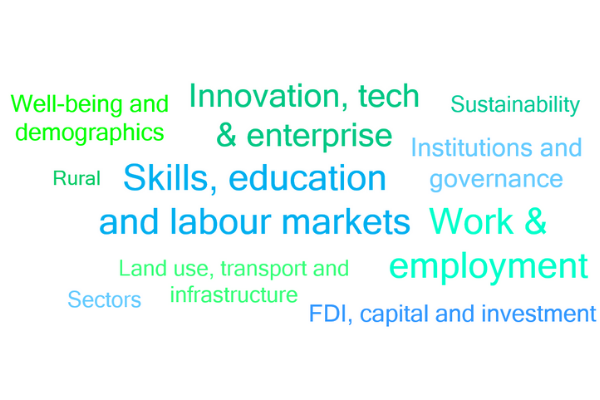Image created by Kat Sloan via Canva.
By Sandra Lancheros, Josh Cave, Chau Chu, Gladys Huaccha, Effie Kesidou, Annina Kaltenbrunner, Daniel Perez, Joel Rabinovich. (University of Leeds)
The long-standing poor productivity performance of the UK compared to other major economies, as well as the disproportionally wider productivity disparities across regions and nations within the UK, has placed productivity as a top priority in the UK government agenda in recent years. Such policy priority has been reflected in the 2017 Industrial Strategy and in the more recent 2021 Build Back Better plan for growth, which acknowledged that “productivity gains are the fundamental source of improvements in prosperity”.
A fundamental piece of the puzzle to boosting productivity at the local, regional, and national levels is to encourage private firms to undertake long-term productivity enhancing investments, such as research and development; innovations in new products and processes; staff training; digital capabilities, etc. From a business-level perspective, accessing appropriate external sources of finance has proved to be essential to materialize such productivity-enhancing opportunities. However, UK companies, especially those of smaller size, still struggle to access to the type of finance they need to fund their productivity improvements. Moreover, with the increasing concentration of finance in central areas of the UK, there is evidence of important regional disparities in business access to finance, which is likely to explain part of the observed imbalances in productivity across regions in the UK.
To test this conjecture, in our Project we examined how different sources of finance shape the productivity of UK companies and evaluated whether the uneven spatial distribution of the UK financial system influences the finance-productivity link. Using a combination of quantitative and qualitative methods, we found that UK companies, particularly small and medium enterprises (SMEs) located in peripheral areas, rely heavily on internal sources (e.g. cashflow) of finance to fund their productivity enhancements; whereas the role of external finance (e.g. bank lending and equity finance) is extremely limited to support these investments, particularly in the peripheral areas of the UK. Taken together, our results indicate that the uneven distribution of the UK financial system has important implications for firm’s productivity and that unless firms are already profitable and capable to generate internal resources, productive innovations are more likely to be discouraged in peripheral than central areas.
From a public policy perspective, the results of our project point to the need to seriously address the geographical imbalances in business ability to access external finance in order to effectively achieve the government’s ambition of levelling up the UK economy and building an environmentally friendly, and socially just recovery from the Covid-19 pandemic. While providing direct regional public support is an important step towards reducing the existing regional financial gaps to support firms’ productivity, it is also critical that the UK private financial system is aligned with the government’s agenda.
In this blog post we present a summary of the main results from our quantitative and qualitative analyses, and provide policy recommendation to rebalance the access to finance by business across all regions and nations in the UK.
Our quantitative analysis:
In our quantitative analysis we evaluate how financial factors shape the productivity of UK companies, and assess whether the geographical distance of the firm to a large financial center matters. Our investigation, based on over 15,000 UK companies during the period 2001-2018, shows that UK firms heavily rely on internal sources of finance to fund their productive investments, and that the dependence on internal finance is stronger the further away the firm is from the core financial centers of the UK. Moreover, this strong dependence is particularly acute for SMEs in the peripheral areas.
Although external sources of finance also contribute to boost the productivity of UK firms, the effect is significantly smaller than that the impact of internally generated financial sources. For example, an increase in the cashflow of the firm by 1 percentage point increases its productivity by 0.5 percent; whereas a similar increase in debt enhances productivity by only 0.07 percent (i.e. seven times less). These results suggest that external finance is still limited in its ability to provide effective funding for productivity-enhancing investments amongst UK companies. Moreover, our results show that the effects of external finance on firms’ productivity decrease with the distance of the firm to its nearest financial center. A potential explanation for this result is that in spatially-centralized financial systems, like the UK, firms in close proximity to financial centers have more opportunities to provide financial institutions with more complete soft information about their projects than firms in the peripheral areas.
Indeed, a body of work in the field of financial geography has suggested that with the development of financial technologies, the funding decisions made by financial institutions are now based on “hard information about the actual performance of the firm” rather than on soft information about the potential of the project to achieve growth, which was traditionally obtained by close communication between the firm and its potential funder located in their local areas (Alessandrini et. al. 2009. 2010). These technological developments coupled with the increased concentration of financial decisions in central areas, has left peripheral firms with less opportunities to disclose the full information about the potential of their projects to the funders.
Our qualitative analysis
To deepen our understanding of the link between finance and productivity, and the role of the UK geography of finance in shaping this relationship, we conducted a series of interviews with business leaders of Micro, Small, and Medium enterprises (MSMEs) in the Leeds City Region. The findings from our interviews were in line with our quantitative analysis and indicated that firms in the Leeds City Region frequently rely on internal sources of finance or personal income to fund their productivity enhancements.
When looking at the use of external sources of finance to fund productivity-enhancing investments, we found that, ahead of the Covid-19 pandemic, accessing bank lending was extremely difficult due to the preference of banks to provide loans collateralized with high-quality business assets (such as real estate property) or with the use of personal guarantees, exposing the entrepreneurs’ own wealth to risk. As such, much of the bank lending was suitable for the acquisition of physical capital, or to support low risk investments, whereas riskier and more productive investments such as long-term innovative activities, as well as new ventures and start-ups were not supported by banks.
Our interviewees made it clear that the difficulty in accessing bank lending has worsened with the move from relationship banking to automated and standardized loan provision in the recent decades. Indeed, whereas in relationship banking, bank managers assessed the risk of business lending based on long-standing contacts and knowledge of the business, these sources of “soft” information have disappeared in the age of digitalized and standardized credit assessment.
Overall, the perception of our interviewees about the limited role of bank lending to fund productive projects is accurately mirrored by the aggregate distribution of bank credit in the UK, which indicates that only 8.5% of the loans provided by banks are directed towards non-financial business and an astonishingly small fraction of such business bank loans (2%-5%) are directed towards the smallest firms. Moreover, there is ample evidence that bank lending has been largely concentrated in the central areas of the UK (Lee and Brown, 2017).
Due to the difficulty in accessing bank lending, some business leaders in the Leeds City Region have actively sought for diverse types of equity capital (such as individual investors, crowdfunding, business angels, mezzanine finance, and venture capital) to fund their innovative activities. In doing so, some of our interviewees indicated that the government’s tax relief schemes, such as the Seeds Enterprise Investment Scheme (SEIS) and the Enterprise Investment Scheme (EIS), have proved to be useful tools to raise funds from private investors. However, aggregate statistics show a bleak picture of the potential of peripheral firms to access equity finance under such schemes. According to official figures, the year prior to the Covid-19 pandemic, 65% and 71% of the funds raised by firms under EIS and SEIS respectively were concentrated in in London and the South East.
In addition to the uneven geographical distribution of equity finance, our interviewees indicated that accessing this source of finance not only requires a strong business plan, but also confident and well-connected owners and managers, willing to devote a great deal of their time and energy toward fund raising. As pointed by one of our interviewees, the difficulty and stress associated with fundraising has a disproportionally negative effect on business with low social connections and/or time to raise money.
To overcome the barriers to accessing private sources of finance to fund their innovative activities, business in the Leeds City Region have also applied to National and local government grants and loans. The general perception of our interviewees about government support is that before the Covid-19 pandemic accessing public funds was a rather time consuming and complicated process in its different stages: from the application for funding all the way through the execution of the project. Moreover, grant funding, which is received on a reimbursement basis, was deemed unsuitable for firms with a lower cash base. Our interviewees, however, acknowledged, that the recent package of financial support (both grants and loans) provided by the Government during current pandemic crisis has been “the most efficient, easiest, quickest, and friendly they have ever had”.
Interestingly, aggregated statistics provided by British Business Bank also show that the Government support via its coronavirus debt guarantee schemes, which has been irrigated through the financial system, has been evenly spread across the UK geography. While some firms have been using these loans to address their immediate liquidity needs, others have maintained a significant proportion of this facility unspent, waiting for potential productivity-enhancing opportunities during the recovery phase. Some of our interviewees mentioned that the government backed loans constitute an ideal source of finance to fund productivity enhancements and expansions: not only have these credits come with favourable terms and conditions, but they also offer great flexibility to be used according to the business’s needs and opportunities.
Conclusions and policy recommendations
The results of our project suggests that part of the regional productivity puzzle in the UK can be explained by the uneven geographical distribution of the business finance provided by the private financial system. In order to address the regional financial gap in funding of productivity-enhancing investments and to contribute toward the challenge of leveling up the UK economy and building back economic growth, direct public support of SME’s as well as the repurposing of the UK financial system are necessary. Two key policy recommendations that emerge from our analysis are:
- Simplify the processes of accessing all forms of government support and ensure that public funding reaches the less advantageous geographical areas of the UK.
Given the high barriers to access private external sources of finance, government grants and loans are a suitable alternative source of finance for business to fund their productive-enhancing investments. Our interviews evidenced that accessing public funding helps firms to access private finance, so government support has a multiplier effect in the ability of firms to raise funding. It is important to simplify not only the application process, but also streamline the monitoring procedures during the execution of the project. The disbursements of the projects should also be flexible according to the firm’s needs. The Covid-19 crisis has proven that government support can be provided in a timely, advantageous, and flexible way. It is therefore important to adapt and maintain these supporting mechanisms beyond the pandemic, ensuring that funds are spread across the less advantaged geographies of the UK.
- Supporting and establishing regional and local banks to fill regional and local financial gaps.
Our results showed that a highly concentrated financial system disadvantages peripheral firms and could lead to a further concentration of productive activities in a small number of over-represented regions of the country, with the consequence of increased spatial inequality. Supporting and establishing regional and local banks is therefore important to cater to less advantageous regions. Specifically, in relation to the recent emergence of UK challenger banks and the governments “leveling up” agenda, we propose a close collaboration between the existing regional government agencies (e.g. the Local Enterprise Partnerships LEPs-) and regional challenger banks – such as Birmingham Bank – as a means of addressing the current misallocation of funds. It is our opinion that small to medium size financial intermediaries are pivotal in addressing the shortage of available funds for SME’s since not only are these institutions regional in nature, but also have mission statements and objectives aligned towards local development.
Accordingly, the possible collaboration between regional authorities and regional financial institutions can be made to encourage local community development and mutually beneficial local lending strategies, whereby local authorities can i) assist in the alleviation of poor information dissemination by providing funding information to local business (for example, through programs such as the Investment Readiness Program provided by the Leeds City Region Enterprise Partnership) and ii) by further sharing part of the lending risk burden via a potential government-backed lending scheme similar to that witnessed in the recent pandemic.
References
Alessandrini, P., Presbitero, A.F. and Zazzaro, A., 2009. Banks, distances and firms’ financing constraints. Review of Finance, 13(2), pp.261-307.
Alessandrini, P., Presbitero, A.F. and Zazzaro, A., 2010. Bank size or distance: what hampers innovation adoption by SMEs?. Journal of Economic Geography, 10(6), pp.845-881.
Lee, N. and Brown, R., 2017. Innovation, SMEs and the liability of distance: the demand and supply of bank funding in UK peripheral regions. Journal of Economic Geography, 17(1), pp.233-260.


























